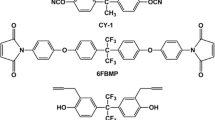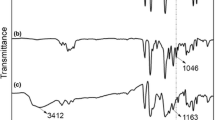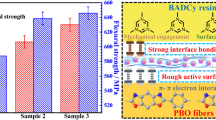Abstract
A novel epoxy and fluorine-containing linear random copolymer of P(PFS-co-GMA) is synthesized from pentafluorostyrene (PFS) and glycidyl methacrylate (GMA) via RAFT polymerization, which is then performed to prepare modified bisphenol A dicyanate ester (m-BADCy) resin. Small dipole and low polarizability of C–F bond in PFS improve the wave-transparent performance of m-BADCy resin. Besides, the large free volume of P(PFS-co-GMA) and formation of semi-IPN structure simultaneously enhances the mechanical properties. The obtained m-BADCy resin with 15 wt% P(PFS-co-GMA) demonstrated the optimal comprehensive properties. ε and tanδ were 2.59 and 0.0053, respectively, lower than that of pure BADCy resin (2.97 and 0.0090). The corresponding wave transmittance (|T|2) increased from 92.9% of pure BADCy resin to 94.5%. Meanwhile, the corresponding flexural and impact strength increased to 122.4 MPa and 14.6 kJ/m2, increased by 23.1% and 49.0% compared with pure BADCy resin (99.4 MPa and 9.8 kJ/m2), respectively.
Graphical abstract
A novel epoxy and fluorine containing linear random copolymer of P(PFS-co-GMA) was synthesized from pentafluorostyrene (PFS) and glycidyl methacrylate (GMA) via RAFT polymerization, which was then performed to prepare modified bisphenol A dicyanate ester (m-BADCy) resin. The m-BADCy resin displayed significantly improved wave-transparent performance and mechanical properties, while maintaining excellent thermal properties.








Similar content being viewed by others
References
Chen Z, Luo J, Huang Z, Cai C, Tusiime R, Li Z, Wang H, Cheng C, Liu Y, Sun Z, Zhang H, Yu J (2020) Synergistic toughen epoxy resin by incorporation of polyetherimide and amino groups grafted MWCNTs. Compos Commun 21:100377.
Zhou Y, Liu F, Chen C-Y (2019) Use of BN-coated copper nanowires in nanocomposites with enhanced thermal conductivity and electrical insulation. Adv Compos Hybrid Mater 2(1):46–50
Han X, Yuan L, Gu A, Liang G (2018) Development and mechanism of ultralow dielectric loss and toughened bismaleimide resins with high heat and moisture resistance based on unique amino-functionalized metal-organic frameworks. Compos Part B-Eng 132:28–34
Pisani W A, Radue M S, Patil S U, Odegard G M (2021) Interfacial modeling of flattened CNT composites with cyanate ester and PEEK polymers. Compos Part B-Eng 211:108672.
Tang L, Zhang J, Gu J (2021) Random copolymer membrane coated PBO fibers with significantly improved interfacial adhesion for PBO fibers/cyanate ester composites. Chinese J Aeronaut 34(2):659–668
Wang B, Zhang Z, Pei Z, Qiu J, Wang S (2020) Current progress on the 3D printing of thermosets. Adv Compos Hybrid Mater 3(4):462–472
Li W, Huang W, Kang Y, Gong Y, Ying Y, Yu J, Zheng J, Qiao L, Che S (2019) Fabrication and investigations of G-POSS/cyanate ester resin composites reinforced by silane-treated silica fibers. Compos Sci Technol 173:7–14
Zhang X, Wang F, Zhu Y, Qi H (2019) Cyanate ester composites containing surface functionalized BN particles with grafted hyperpolyarylamide exhibiting desirable thermal conductivities and a low dielectric constant. RSC Adv 9(62):36424–36433
Gu J, Xu S, Zhuang Q, Tang Y, Kong J (2017) Hyperbranched polyborosilazane and boron nitride modified cyanate ester composite with low dielectric loss and desirable thermal conductivity. IEEE T Dielect El In 24(2):784–790
Arumugam V, Kanthapazham R, Zherebtsov DA, Kalimuthu K, Pichaimani P, Muthukaruppan A (2021) Fluorine free TiO2/cyanate ester coated cotton fabric with low surface free energy and rough surface for durable oil-water separation. Cellulose 28(8):4847–4863
Chandrasekaran S, Duoss EB, Worsley MA, Lewicki JP (2018) 3D printing of high performance cyanate ester thermoset polymers. J Mater Chem A 6(3):853–858
Tang L, Dang J, He M, Li J, Kong J, Tang Y, Gu J (2019) Preparation and properties of cyanate-based wave-transparent laminated composites reinforced by dopamine/POSS functionalized Kevlar cloth. Compos Sci Technol 169:120–126
Li S, Zhu Y, Wang Y, Wang B, Huang Y, Yu T (2021) Cyanate ester resin based composites with high toughness and low outgassing performances. Compos Commun 23:100574.
Vashchuk A, de Anda AR, Starostenko O, Grigoryeva O, Sotta P, Rogalsky S, Smertenko P, Fainleib A, Grande D (2018) Structure-property relationships in nanocomposites based on cyanate ester resins and 1-heptyl pyridinium tetrafluoroborate ionic liquid. Polymer 148:14–26
Fang L, Zhou J, Tao Y, Wang Y, Chen X, Chen X, Hou J, Sun J, Fang Q (2019) Low dielectric fluorinated polynorbornene with good thermostability and transparency derived from a biobased allylphenol (eugenol). ACS Sustain Chem Eng 7(4):4078–4086
He F, Gao Y, Jin K, Wang J, Sun J, Fang Q (2016) Conversion of a biorenewable plant oil (anethole) to a new fluoropolymer with both low dielectric constant and low water uptake. ACS Sustain Chem Eng 4(8):4451–4456
Jiang Q, Zhang W, Hao J, Wei Y, Mu J, Jiang Z (2015) A unique “cage-cage’’ shaped hydrophobic fluoropolymer film derived from a novel double-decker structural POSS with a low dielectric constant. J Mater Chem C 3(44):11729–11734
Hu J, Gu A, Jiang Z, Liang G, Zhuo D, Yuan L, Zhang B, Chen X (2012) High efficiency synthesis of octavinylsilsesquioxanes and its high performance hybrids based on bismaleimide-triazine resin. Polym Advan Technol 23(8):1219–1228
Zhang Z, Pei J, Liang G, Yuan L (2011) Methyl silsesquioxane/cyanate ester resin organic-inorganic hybrids with low dielectric constant. J Appl Polym Sci 121(2):1004–1012
Devaraju S, Vengatesan MR, Selvi M, Song JK, Alagar M (2013) Mesoporous silica reinforced cyanate ester nanocomposites for low k dielectric applications. Micropor Mesopor Mat 179:157–164
Wu Z, Zhao L, Qi L, Jiao J (2017) Improved cyanate resin with low dielectric constant and high toughness prepared using inorganic-organic hybrid porous silica. Chem Lett 46(1):139–142
Guo X, Deng H, Fu Q (2020) An unusual decrease in dielectric constant due to the addition of nickel hydroxide into silicone rubber. Compos Part B-Eng 193:108006.
Liu J, Fu Y, Fu X, Li Y, Liang D, Song Y, Pan C, Yu G, Xiao X (2016) Nanoscale porous triazine-based frameworks with cyanate ester linkages for efficient drug delivery. RSC Adv 6(25):20834–20842
Milliman HW, Boris D, Schiraldi DA (2012) Experimental determination of hansen solubility parameters for select POSS and polymer compounds as a guide to POSS-polymer interaction potentials. Macromolecules 45(4):1931–1936
Liu Z, Yuan L, Liang G, Gu A (2015) Tough epoxy/cyanate ester resins with improved thermal stability, lower dielectric constant and loss based on unique hyperbranched polysiloxane liquid crystalline. Polym Advan Technol 26(12):1608–1618
Ye J, Liang G, Gu A, Zhang Z, Han J, Yuan L (2013) Novel phosphorus-containing hyperbranched polysiloxane and its high performance flame retardant cyanate ester resins. Polym Degrad Stabil 98(2):597–608
Wang B, Shang Y-R, Ma Z, Pan L, Li Y-S (2017) Non-porous ultra low dielectric constant materials based on novel silicon-containing cycloolefin copolymers with tunable performance. Polymer 116:105–112
Ariraman M, Sasikumar R, Alagar M (2015) Hybridization of PDMS based cyanate ester and DGEBA for radiation resistant and microelectronics applications. RSC Adv 5(78):63641–63649
Liu J, Meng Q, Li L, Lu G, Yuan H, Cui L, Liu X, Mu H, Ji J, Zhou D, Wang Z, Yan J (2020) A high-performance polycyanurate network derived from 4, 4’-biscyanato-2, 2’-trifluoromethylbiphenyl. Polym Chem 11(4):784–788
Tao Y, Zhou J, Fang L, Wang Y, Chen X, Chen X, Hou J, Sun J, Fang Q (2019) Fluoro-containing polysiloxane thermoset with good thermostability and acid resistance based on the renewable multifunctional vanillin. ACS Sustain Chem Eng 7(7):7304–7311
Yuan C, Jin K, Li K, Diao S, Tong J, Fang Q (2013) Non-porous low-k dielectric films based on a new structural amorphous fluoropolymer. Adv Mater 25(35):4875–4878
Wang C, Tang Y, Zhou Y, Zhang Y, Kong J, Gu J, Zhang J (2021) Cyanate ester resins toughened with epoxy-terminated and fluorine-containing polyaryletherketone. Polym Chem 12(26):3753–3761
Liu Z, Fan X, Zhang J, Yang Z, Tang Y, Li J, Kong J, Gu J (2021) Improving the comprehensive properties of PBO fibres/cyanate ester composites using a hyperbranched fluorine and epoxy containing PBO precursor. Compos Part A-Appl S 150:106596.
Tang L, Zhang J, Tang Y, Kong J, Liu T, Gu J (2021) Polymer matrix wave-transparent composites: A review. J Mater Sci Technol 75:225–251
Yin Q, Alcouffe P, Beyou E, Charlot A, Portinha D (2018) Controlled perfluorination of poly(2, 3, 4, 5, 6-pentafluorostyrene) (PPFS) and PPFS-functionalized fumed silica by thiol-para-fluoro coupling: Towards the design of self-cleaning (nano) composite films. Eur Polym J 102:120–129
Atanasov V, Kerres J (2011) Highly phosphonated polypentafluorostyrene. Macromolecules 44(16):6416–6423
Atanasov V, Oleynikov A, Xia J, Lyonnard S, Kerres J (2017) Phosphonic acid functionalized poly(pentafluorostyrene) as polyelectrolyte membrane for fuel cell application. J Power Sources 343:364–372
Bucholz TL, Li SP, Loo Y-L (2008) Ultra-low-k materials derived from poly(D, L-lactide-b-pentafluorostyrene) diblock copolymers. J Mater Chem 18(5):530–536
Fu GD, Kang ET, Neoh KG, Lin CC, Liaw DJ (2005) Rigid fluorinated polyimides with well-defined polystyrene/poly(pentafluoro styrene) side chains from atom transfer radical polymerization. Macromolecules 38(18):7593–7600
Inamdar A, Cherukattu J, Anand A, Kandasubramanian B (2018) Thermoplastic-toughened high-temperature cyanate esters and their application in advanced composites. Ind Eng Chem Res 57(13):4479–4504
Liu J, Fan W, Lu G, Zhou D, Wang Z, Yan J (2019) Semi-interpenetrating polymer networks based on cyanate ester and highly soluble thermoplastic polyimide. Polymers 11(5):862
Zhou Z-X, Li Y, Zhong J, Luo Z, Gong C-R, Zheng Y-Q, Peng S, Yu L-M, Wu L, Xu Y (2020) High-performance cyanate ester resins with interpenetration networks for 3D printing. ACS Appl Mater Inter 12(34):38682–38689
Liu Z, Zhang J, Tang Y, Xu J, Ma H, Kong J, Gu J (2021) Optimization of PBO fibers/cyanate ester wave-transparent laminated composites via incorporation of a fluoride-containing linear interfacial compatibilizer. Compos Sci Technol 210:108838.
Zhao B, Bai Z, Guo X, Zhang R, Jiang Q, Guo Z (2021) Poly(vinylidene fluoride)/Cu@Ni anchored reduced-graphene oxide composite films with folding movement to boost microwave absorption properties. Engineered Science, https://doi.org/10.30919/esee8c488.
Osipov AV (2014) Minimum reflection properties of planar impedance-matched boundaries. Ieee T Antenn Propag 62(11):5666–5670
Wu N, Zhao B, Liu J, Li Y, Chen Y, Chen L, Wang M, Guo Z (2021) MOF-derived porous hollow Ni/C composites with optimized impedance matching as lightweight microwave absorption materials. Adv Compos Hybrid Mater 4:707–715
Xie P, Liu Y, Feng M, Niu M, Liu C, Wu N, Sui K, Patil RR, Pan D, Guo Z, Fan R (2021) Hierarchically porous Co/C nanocomposites for ultralight high-performance microwave absorption. Adv Compos Hybrid Mater 4(1):173–185
Zhao J, Zhang J, Wang L, Li J, Feng T, Fan J, Chen L, Gu J (2020) Superior wave-absorbing performances of silicone rubber composites via introducing covalently bonded SnO2@MWCNT absorbent with encapsulation structure. Compos Commun 22:100486.
Funding
This research was financially supported by the National Scientific Research Project (Basis Strengthening Plan) and China Postdoctoral Science Foundation (2019M653735). C. Q. and L. L. acknowledge the Undergraduate Innovation & Business Program in Northwestern Polytechnical University for funding (S202110699153 and S202110699571). This work is also financially supported by Polymer Electromagnetic Functional Materials Innovation Team of Shaanxi Sanqin Scholars.
Author information
Authors and Affiliations
Corresponding authors
Ethics declarations
Conflict of interest
The authors declare no competing interests.
Additional information
Publisher's Note
Springer Nature remains neutral with regard to jurisdictional claims in published maps and institutional affiliations.
Supplementary Information
Below is the link to the electronic supplementary material.
Rights and permissions
About this article
Cite this article
Zhou, Y., Zhang, J., Qu, C. et al. Synchronously improved wave-transparent performance and mechanical properties of cyanate ester resins via introducing fluorine-containing linear random copolymer. Adv Compos Hybrid Mater 4, 1166–1175 (2021). https://doi.org/10.1007/s42114-021-00349-3
Received:
Revised:
Accepted:
Published:
Issue Date:
DOI: https://doi.org/10.1007/s42114-021-00349-3




